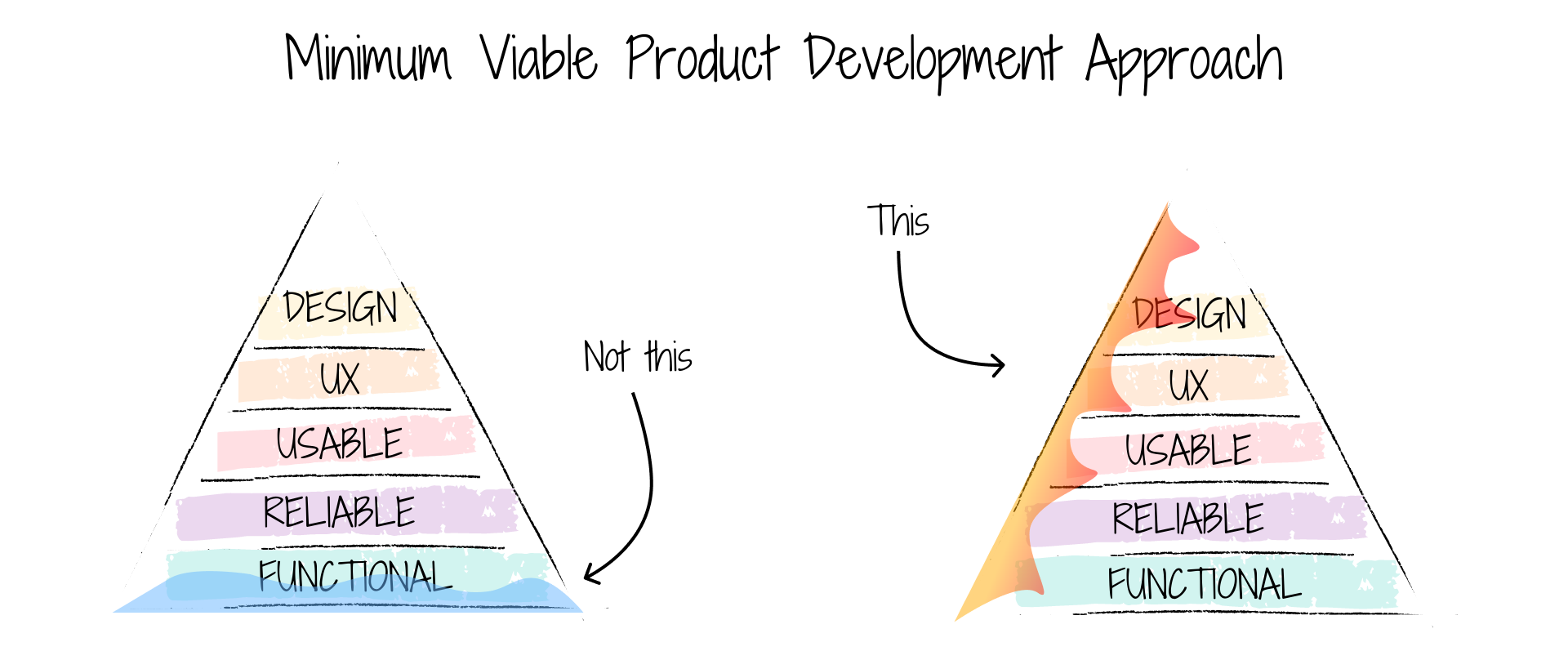What’s an MVP? Why do I need one for my start-up? How do I build one?
A core component of the lean philosophy is the Minimum Viable Product (MVP). Understanding the concept of the MVP will help you focus on the things that matter most while saving you time.

What is an MVP (Minimum Viable Product)?
An MVP (Minimum viable product) is a basic, launchable version of the product that supports minimal yet must-have features (which define its value proposition). An MVP is created with an intent to enable faster time to market, attract early adopters, and achieve product-market fit from early on.

What is the MVP Development Process?
An MVP has just the basic functionalities that demonstrate the product and its ability to solve a user problem.
It is building a slice across the whole development process rather than one layer at a time.
Less development time means lower development costs. The faster the product is launched to users, the faster the business will receive feedback. This means they can work on improving their product, and release an updated version quickly.

In order to build the smallest functioning version of our product, we need to identify the core features that we can’t do without, and the “nice to have” features we need to save for later iterations.
Thankfully, there are dozens of different frameworks for prioritizing your feature list, including the MoSCoW method: a way of splitting your features list into Must Haves, Should Haves, Could Haves, and Won’t Haves:
MUST HAVE
These are the bare-bones features that are inextricably linked to the functionality of your product. The features that end up here constitute the backbone of your Minimum Viable Product.
SHOULD HAVE
These are features that a finished product needs to have, but aren’t essential for this early-stage iteration. For example, you know your product will eventually need an automated password recovery system, but you can use a manual email support system for your MVP.
COULD HAVE
This is where all of your desirable, added-extra functionality goes: ready to be built out only once you’ve tested the core functionality of your product.
WON’T HAVE
Sometimes, it can be valuable to define the high resource, low reward features your product shouldn’t have.
Advantages of MVPs
If you haven’t decided if building an MVP is a good idea, we prepared a list of advantages for it:
- It will save you money & development with minimal risks.
- Building a new product can be expensive, but starting with an MVP will reduce your entire cost.
- An MVP gives you room for evolution. Firstly, if some new technologies arise, you can integrate them fairly and softly. Secondly, it’s much easier to add new features than to remove unnecessary ones. Basically, MVP keeps the product concept flexible for the latest changes.
- Verify market demand. Fast & affordable idea validation.
- You will have a clear analysis from the beginning, and the users will validate the idea in its early stages.
- Minimum viable product development requires minimum features to test the idea and, therefore — minimum time to build it. You invest time&resources on the vital parts of the product only. It’s the cheapest form of the product that shows you how the real users will react to it.
- A better understanding of the users’ needs. Build a product that people use.
- It’s a widespread case that founders have an image of how the future product should look and stick to that. The point here is that this image should be very flexible if you want to build a product for people. With an MVP and meaningful feedback from users, you can implement only essential features and remove everything that is not functional.
- Whether, or not your idea gets validated, you will know exactly what can be improved in the future.
You can’t build a product for people without asking what they need.
- Quicker release.
- Your idea will see the light of the day really fast, even if in a raw shape.
- Attention from investors.
- MVP is a showcase of your concept. It allows you to show your concept instead of talking about it for hours. Moreover, if you get people to use the product and find value in it, your chances of getting the investments raise drastically.
- A better understanding of the domain.
- When you decide to build an MVP, you start to dig deeper into the problem, industry, and market. In general, you get better domain knowledge and find out white space opportunities. If you start to build a full-fledged product right away, you will miss it.
Who can help build an MVP?
We are a digital agency full of open-minded, passionate, and highly skilled people, experienced in building MVPs. We want you to succeed. We will focus on the vital features needed to test your product’s main assumptions - leaving unnecessary features behind, or saving them for later iterations. We don’t want to help you build a full-featured product only to discover the market doesn’t want it, but if the MVP gets validated, we can build a strategy to scale your start-up We already have some clients that worked with us in the early stages of their businesses and now we are working together to transform them into scalable products. We build systems that can be scaled up so you can gain valuable insight and funding to develop further. It’s time to find out just how strong your idea is.
If you want some specific details about how we can help you or if you want a piece of advice from professionals, please contact us directly and we are happy to jump on a FREE consulting call.
Just go to dutyventures.com/meet and schedule a FREE call with us!
Always on duty,
Duty Team

